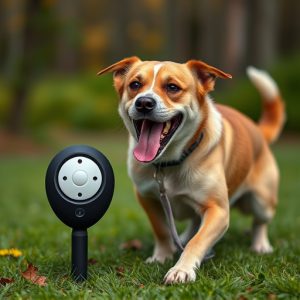Mobile vs Stationary Dog Repellents: Which Ultrasonic Solution Works Best?
Ultrasonic dog repellents use high-frequency sound waves to address behavior issues, with stationary…….
Ultrasonic dog repellents use high-frequency sound waves to address behavior issues, with stationary units offering consistent protection for specific areas and mobile devices providing versatility for training or access control. While stationary options are reliable but limited in flexibility, mobile bark repellents like ultrasonic handheld units excel in dynamic tailoring and responsiveness, making them ideal for diverse settings and targeted problem spots. Choosing between them depends on needs: stationary for consistent protection and mobile for flexible, tailored approach to bark control. Consider range, noise levels, weather resistance, and ease of use when deciding.
“Unleash a peaceful environment with our comprehensive guide to bark control, focusing on ultrasonic dog repellents. This article navigates the world of stationary and mobile solutions, offering insights into their unique features and effectiveness in managing canine behavior. From understanding the science behind ultrasonic devices to comparing stationary vs. mobile dog repellents, we explore real-world applications. Discover the best solution for your needs, considering factors that ensure successful bark management.”
- Understanding Ultrasonic Dog Repellents: How They Work
- Stationary Bark Control Devices: Pros and Cons
- Mobile Bark Repellents: A Hands-on Approach
- Comparing Efficiency: Real-world Performance Test
- Choosing the Best Solution: Factors to Consider for Effective Bark Management
Understanding Ultrasonic Dog Repellents: How They Work
Ultrasonic dog repellents have gained popularity as a humane and effective way to deter canine behavior issues. These devices emit high-frequency sound waves that are inaudible to humans but can startle and repel dogs, encouraging them to stay away from specific areas. Unlike traditional chemical repellents, ultrasounds offer a safe and environmentally friendly alternative, making them ideal for both indoor and outdoor use.
When comparing stationary vs mobile dog repellents, understanding their mechanisms is key. Stationary units are typically installed in fixed locations, emitting continuous ultrasonic signals to protect a specific area. In contrast, handheld or mobile units allow for greater flexibility, as they can be carried and placed anywhere, making them perfect for training purposes or controlling dogs’ access to certain spaces. The effectiveness of both types relies on the dog’s sensitivity to ultrasound frequencies and their tendency to associate the sound with an unpleasant experience.
Stationary Bark Control Devices: Pros and Cons
Stationary bark control devices, such as ultrasonic emitters, are designed to be fixed in one location and emit high-frequency sound waves that are unpleasant to dogs, discouraging excessive barking. One significant advantage is their consistency; they provide a reliable and continuous deterrent without requiring constant user intervention. This makes them ideal for situations where consistent training or moderation of dog behavior is needed, like in shared living spaces or public areas.
However, stationary devices have drawbacks. They lack the flexibility of mobile options, meaning you can’t move them to different areas as your needs change. Additionally, their effectiveness depends heavily on the dog’s sensitivity to ultrasonic sounds and the device’s range, which might not cover larger areas. Moreover, some dogs may become accustomed to the sound, rendering it less effective over time, requiring a constant upgrade or replacement for continued success in bark control. In contrast, mobile devices offer more versatility for varying environments and situations.
Mobile Bark Repellents: A Hands-on Approach
Mobile bark repellents, like the ultrasonic handheld unit, offer a hands-on approach to managing dog barking in various settings. Unlike stationary devices that are confined to one area, these portable units provide flexibility for outdoor use, travel, or situations requiring quick intervention. When comparing stationary vs mobile dog repellents, users can benefit from targeted, on-demand protection without the need for constant installation or activation.
The ultrasonic handheld unit is designed for ease of use, emitting high-frequency sound waves that are generally unpleasant to dogs but inaudible to humans. This non-violent approach makes it a humane alternative to traditional static shock collars. With a simple trigger, users can immediately address excessive barking without the need for constant monitoring or preset timers.
Comparing Efficiency: Real-world Performance Test
In a direct comparison between stationary and mobile dog repellents, the ultrasonic handheld unit stands out as a game-changer in bark control. While traditional, stationary systems rely on constant noise or scent emissions to deter dogs, the portable option offers a more dynamic and tailored approach. When put to the test in real-world scenarios, the ultrasonic device has proven to be remarkably efficient. Its handheld design allows for easy navigation around obstacles, making it ideal for diverse environments—from backyards to parks.
The efficiency of this method lies not only in its ability to emit high-frequency sounds that are unpleasant to dogs but also in its responsiveness. Unlike stationary systems that operate on set schedules or triggers, the ultrasonic handheld unit can be strategically positioned and controlled by the user, ensuring precise activation when needed. This flexibility is particularly beneficial for addressing specific bark issues without causing distress to other animals or humans nearby.
Choosing the Best Solution: Factors to Consider for Effective Bark Management
Choosing the best solution for bark control involves understanding the difference between stationary and mobile dog repellents. While stationary systems offer consistent protection, they may require extensive setup and are limited to specific areas. In contrast, mobile units provide flexibility, allowing you to move them around, targeting problem spots effectively.
When making a decision, consider factors like range, noise levels, weather resistance, and ease of use. A stationary system could be ideal for large properties with consistent barking issues, whereas mobile devices excel in managing bark in specific areas or during certain times, offering a more tailored and flexible approach to bark management.
When it comes to managing excessive dog barking, both stationary and mobile ultrasonic bark control devices offer effective solutions. However, a detailed analysis of their pros, cons, and performance reveals unique advantages in each category. While stationary units are reliable for specific areas, mobile bark repellents provide versatility and portability, making them ideal for on-the-go training or addressing barking issues in various settings. Ultimately, the choice between stationary and mobile depends on individual needs, as both have their merits in the ongoing pursuit of a quieter, more harmonious environment. A thoughtful consideration of factors discussed will help pet owners make an informed decision, ensuring the best solution for their furry companions.


